Results from hair transplantation are consistently natural
Demand for the procedure has increased significantly
Lasers have been implemented in the field of hair transplantation to create recipient sites and enhance hair growth
The field of hair transplantation has undergone a significant transformation during the last 10–15 years. With the advent of follicular unit transplantation, patients achieve far better results than they could with the original unnatural punch grafts (Figs. 1–4). This cosmetic revolution has resulted in an ever increasing demand for the procedure. According to the International Society of Hair Restoration Surgery, practice census results from 2006 demonstrated that over 100,000 hair restoration procedures were performed in the United States, up from 88,000 in 2004. Worldwide, over 225,000 people underwent hair transplant surgery in 2006. This translates to a market size of over 1.2 billion dollars in the U.S. alone.1
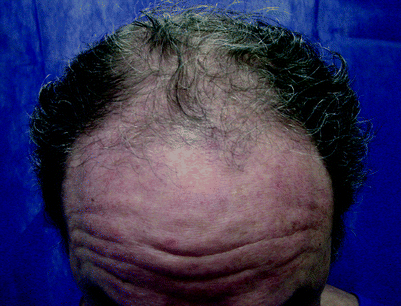

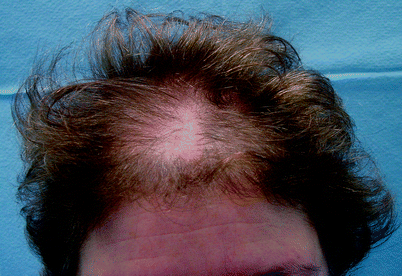
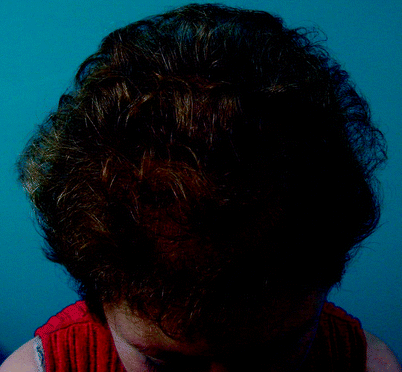

Fig. 1
Patient 1: before hair transplantation

Fig. 2
Patient 1: after 1,000 grafts

Fig. 3
Patient 2: before hair tansplantation

Fig. 4
Patient 2: after 900 grafts
In the last decade, there has been an equally important revolution in the field of laser surgery. The theory of selective photothermolysis introduced in 1983 by Anderson and Parrish served as the intellectual foundation for the laser revolution.2 This chapter will focus on the two major laser applications affecting the hair: (1) laser-assisted creation of recipient sites in hair transplantation, and (2) the use of low-level-laser therapy to increase hair growth. Both applications have faced considerable controversy within the laser and hair transplant community. We attempt to provide a balanced perspective of each so that their roles may be fairly assessed and possibly even implemented.
Lasers in Hair Transplantation
Recipient sites for hair transplantation are usually made with needles Difficulties with hemostasis called for the use of CO2 lasers for recipient site creation In 1996, the FDA approved lasers for use in hair transplantation |
Most physicians performing hair transplant surgery use traditional steel blade trephines or needles to create their recipient sites. In doing so, they face several challenges. The foremost among these is hemostasis. As each new recipient site is created, bleeding makes graft placement difficult and time-consuming. Heavy drinkers or patients on aspirin or blood-thinning supplements may present even more of a challenge. Grafts may pop out and require re-placement. This challenge prevents many interested dermatologic surgeons from entering the field.
Carbon dioxide lasers were introduced in the mid-1960s. They were popularized in the 1970s in dermatologic surgery because of their ability to vaporize tissue and seal blood vessels. The problem with continuous wave carbon dioxide lasers was the peripheral non-specific spread of heat, resulting in widespread scarring of the skin. In the 1990s, the concept of selective photothermolysis was applied to carbon dioxide lasers. By limiting the exposure time of the laser to less than one-half of the thermal relaxation time of the surrounding tissue, there was a significant reduction in lateral thermal damage. This allowed CO2 lasers to vaporize tissue with excellent hemostasis and no scarring. Pulsed CO2 lasers were introduced to treat dermatoheliosis and acne scarring with dramatic results.
At that same time this laser revolution in CO2 lasers was occurring, the field of hair transplantation underwent a similar revolution. The traditional large “pluggy” grafts were abandoned in favor of natural 1–3 hair follicular unit grafts. The problems of bleeding and popping of grafts at recipient sites remained. The investigation of handpieces for creating recipient sites in pulsed CO2 lasers was begun in the mid-1990s to overcome this problem. High energy pulsed CO2 lasers would vaporize tissue and seal dermal vessels with excellent hemostasis.
Initial studies found that average graft hair counts were greater in laser-created sites in four of the ten patients, and looked more natural.3 They also found that there was less bleeding in the laser-created sites, and that the associated grafts required less handling. One pitfall from the excellent hemostasis was that a few of the grafts fell out. By adjusting the laser’s energy down slightly, there was an increase in “biological glue” that kept future grafts from falling out.
Subsequent studies confirmed the ability to make recipient sites with excellent hemostasis and growth of transplanted hair (Figs. 5 and 6).4, 5 These studies led to FDA approval of lasers for hair transplantation in 1996.6–8 FDA approval resulted in a worldwide interest and use of lasers to create recipient sites. Yet, today very few hair surgeons use laser to make recipient sites. What happened?
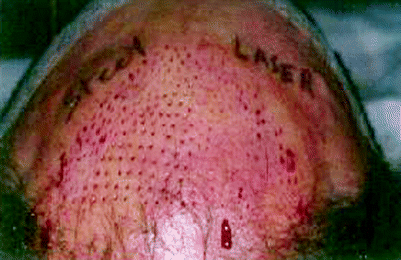
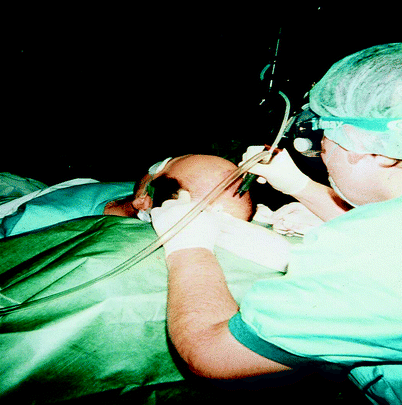

Fig. 5
Laser recipient sites versus steel created sites

Fig. 6
Physician making CO2 laser assisted recipient sites
Lasers have a minor role in hair transplantation Steel needles can provide closer site creation, with less lateral damage, resulting in greater density and less post-surgical hemorrhagic crusting |
Some clinicians and investigators reported superficial de-epithelialization surrounding the sites. This led to greater and longer-lasting crusts post-operatively. Delayed hair growth of 2–6 weeks was also observed.4 The chief obstacle over time was density. Histologic studies of laser-created site showed a minimum of 20–50 μm of lateral thermal damage through the dermis (Fig. 7).9–11 This was enough to create excellent hemostasis and growth of transplanted hair, but it did not allow for close placement of recipient sites among existing hair follicles. Nineteen gauge needles could more safely create closely spaced sites than pulsed CO2 lasers. Physicians who tried placing recipient sites too close together often had a massive telogen of existing hair, poor growth, and in some cases necrosis of the skin.


Fig. 7
Pathology showing CO2 laser assisted recipient sites for hair transplantation
To overcome the lateral tissue necrosis associated with CO2 lasers, clinicians have tried to use holmium:YAG or erbium:YAG lasers instead of traditional CO2 lasers for recipient site creation. Histologic studies of the Ho:YAG (λ = 2,120 nm) demonstrated no advantage over traditional CO2.12 It created jagged, irregular-shaped channels with even larger zones of thermal injury. The Er:YAG (λ = 2,940 nm) has shown promising results in creating recipient sites for both androgenetic alopecia13 and cicatricial alopecia.14 Its use in a 2-year clinical trial produced greater than 95% yield of 1–4-hair follicular units with no reported side effects.15 However, its use has been limited by the lack of hemostasis and the inability to create sites deep enough with single pulse (Fig. 8).
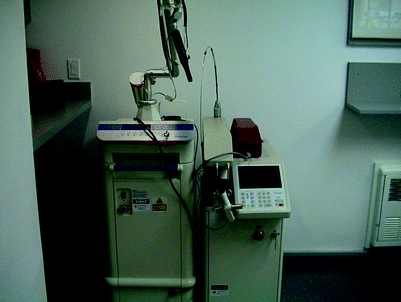

Fig. 8
CO2 laser and Erbium laser
Risks Inherent in CO2 Laser Usage Damage to water-containing organs, such as the cornea Formation of smoke plume containing possibly infectious disease Potential for igniting a fire with concomitant oxygen use with sedation |
Besides the disadvantages stated above, there are risks inherent in the CO2 laser because it targets water as its primary chromophore. Laser operators must be aware of the possibility of damaging organs high in water content, such as the cornea. There is also the formation of a smoke plume which could contain bacteria, viral DNA, or viable cells. The high voltage of a CO2 laser may pose an electrical hazard by igniting tissue, oxygen, or volatile solvents used in hair products.
As seen in (Table 1), there are as many advantages as there are disadvantages to using lasers for hair transplantation. The technique can be helpful for novices to the field, in controlling bleeding and reducing time to place the grafts. However, it may take more time to create sites with an appropriate angle and spacing. Recipient sites cannot be made too close together due to the dermal necrosis. If they are too closely made, widespread necrosis of the scalp may occur. It is unclear whether the vaporization of tissue by laser creates enough density to outweigh this requirement. Ultimately, one must consider factors like the cost of the laser and whether this technique is superior to current standard of practice. It may be hard for an expensive, complex laser to beat the ease and economy of using needles or steel blades, especially when bleeding is not a significant problem for the experienced hair transplant surgeon.
Table 1
Pros and Cons of Lasers in Hair Transplantation
Pros of lasers in hair transplantation |
|---|
1. Improved hemostasis because blood vessels are sealed by laser |
2. Reduced time to plant grafts |
3. May be easier for beginner hair transplant doctors, as well as their assistants |
4. Nerve endings, like blood vessels, are sealed with theoretical reduction in pain3 |
5. May achieve higher density because tissue is vaporized, not just pushed apart12 |
6. Less graft compression, again because alopecic skin measuring 1–2 mm wide is vaporized3 |
7. Less handling of the graft itself, because the laser-prepared sites are wider (1–2 mm) than scalpel created sites. |
8. Don’t have to constantly sharpen 1–2 mm trephines3 |
9. Less risk of cobblestoning (from graft elevation) or pitting (from graft depression) because there is a constant depth of laser-created site3 |
10. Use of less epinephrine9 |
11. Shorter operative time, which translates to less patient discomfort and less staff frustration16 |
12. Lower risk of cyst formation as a result of tissue left behind17 |
Cons of lasers in hair transplantation |
|---|
2. May fray epithelial edges and cause superficial de-epithelialization4 |
4. Delayed (2–6 weeks) regrowth of transplanted follicles4 |
5. Risk of telogen effluvium from heat of laser – may thin sites with existing hair |
6. Increased risk of secondary infection4 |
7. Risk of injury to adjacent hair follicles in recipient area4 |
9. Longer operating time, because of difficulty creating site at the appropriate angle4 |
10. Persistent erythema20 |
11. Learning curve associated with using laser4 |
12. Plume may contain noxious and carcinogenic chemicals |
Perhaps novel fractional ablative devices will be able to create recipient sites as close as #19 and #20 gauge needles without the increased risk of necrosis. Creating a fractional ablative handpiece with a scanner would allow recipient sites to be created quicker, with better hemostasis leading to reduced operating time for patient and physician.
CO2 ablative lasers have FDA approval for hair transplantation. |
Not used in hair transplants due to density. |
If laser transplant is performed, spacing too close will result in telogen effluvium. |
Fractional ablative lasers may allow greater density in the future. |
Lasers in Hair Growth
LLLT (Low Level Light Therapy) is a relatively new modality |
Few studies have so far demonstrated its efficacy in treating hair loss |
Devices are sold without a prescription, through direct-to-consumer marketing |
Given that lasers have historically been used to remove unwanted hair, many physicians are debating whether the low-level-light lasers can really enhance hair growth. Numerous products are being marketed directly to consumers that employ low-level-light-therapy (LLLT) to theoretically thicken and promote the growth of existing follicles. However, these products have so far undergone few double-blind, placebo-controlled trials. It would seem that the manufacturers, in their eagerness to make the products available to the public at large, have forgotten to first convince the scientific community.
Nonetheless, there does seem to be fairly good evidence that these products may work. The earliest study was done by Hungarian researcher Endre Mester in 1967, when he was trying to find out if laser radiation could cause cancer in mice.21




Stay updated, free articles. Join our Telegram channel

Full access? Get Clinical Tree








